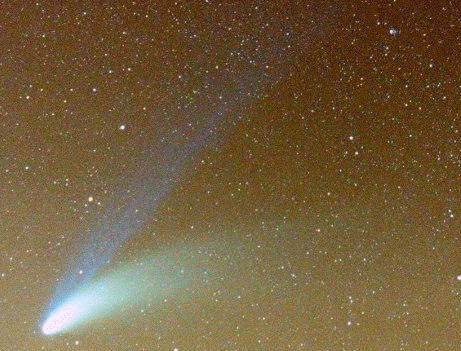Comet Hale-Bopp from an image taken by Nick James on March 29 1997
at 2045 hours UT. The exposure time was 2min a 55mm, f/2 lens and
Fuji SG-800 film was used. The larger image from which this was taken
includes a meteor. The image was downloaded from
The Astromomer magazine's comet page.
 Comet Hale-Bopp is a massive dirty snowball that may be as much as
40 kilometers across.
Comet Hale-Bopp is a massive dirty snowball that may be as much as
40 kilometers across.
We cannot see the comet's nucleus with even our best telescopes. All we see is the cloud of gas and dust that is evaporating from the comet as it is warmed by the sun.
The comet's coma, the cloud of gas and dust surrounding the nucleus, is thousands of kilometers across and the comet's dust, gas and ion tails stretch away for millions of kilometers.
The comet rotates about once every 11 hours and spews out dust and gas in a spiral pattern.
The solar system is permeated with gas and ions that have been blown from the surface of the sun. The comets coma interacts with the solar wind. By studing the comet's bow wave and wake (tails) as it ploughs through the solar system, we learn about the solar wind.
See the NASA-JPL Comet Site's Information on Hale-Bopp for the non astronomer for more information.